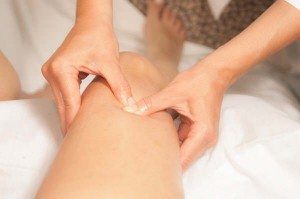Trigger point therapy can be a great technique in the sports massage field, and the results and benefits of this practice are rapidly becoming more popular and demanding among sporting athletes and also the general community. Trigger points are located all over the body up to 300 in total approximately. They are tight adhesion’s in the muscle similar to a small marble or band like shape. These adhesion’s are responsible for a number of problems.
 Trigger Point Therapy Benefits
Trigger Point Therapy Benefits
Trigger Point Therapy can reduce pain, increase movement, and allows the muscles to lengthen and become stronger again. To treat Trigger Points, heavy pressure must be applied to the Trigger Point. Light pressure is not effective for treating Trigger Points, and in fact may increase spasms as the muscle tries to protect itself, leading to increased and more constant pain. In contrast, moderate to heavy pressure applied to a Trigger Point causes the pain to initially increase, but then as the muscle relaxes the pain will fade. The benefits of trigger point therapy are amazing and the list is long. A few of the specific trigger point therapy benefits are instantly abolishing headaches or migraines, increase flexibility, effectively relieve neck, back and muscular pains, treat mistaken tendinitis, frozen shoulders and shoulder impingement problems and much more.
Trigger point therapy is directed at muscle spasms that do not resolve on their own. The constant tension in the fibres of the trigger point itself restricts circulation in its immediate area. The result is the accumulation of the by-products of metabolism, as well as deprivation of the oxygen and nutrients needed for healthy muscle fibres, this can pro long trigger points for months or years.This allows the muscle to relax, resulting in no more pain. Improved range of motion and mobility, less pain, and healthy muscle function are the result. Trigger Point Therapy is used for acute or chronic muscle spasms.
Trigger Point Therapy Results
The best results are found by combining deep tissues remedial massage along with trigger point therapy, this combination allows for good separation and stretching of the muscle fibres while also promoting blood flow, oxygen and muscle tension release to the surrounding area. Pressure should be applied slowly and released slowly for best results. The pressure should be maintained until there is a change in pain. After applying pressure to Trigger Points, the relaxed muscle should be stretched. If the muscles are not returned to normal length, there is a greater likelihood the Trigger Points will reoccur. Stretching is safer and less painful after the Trigger Points have been treated.





